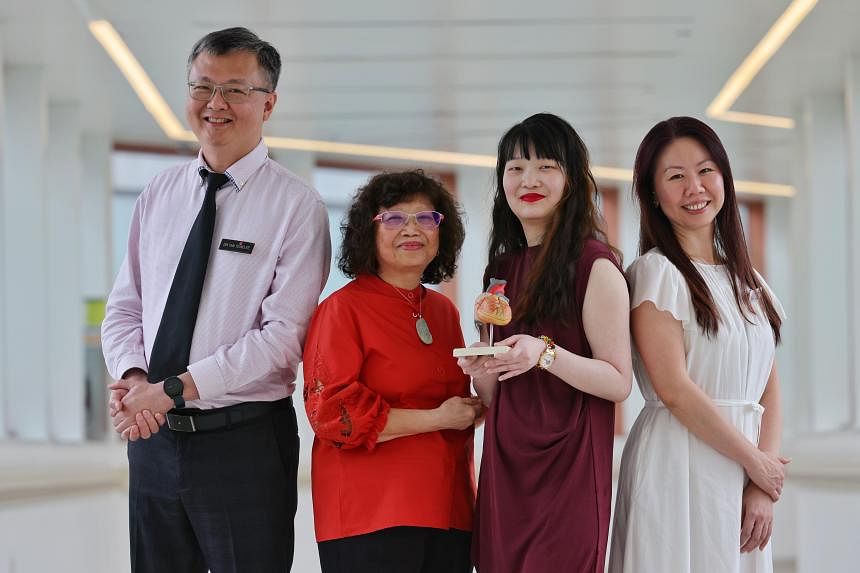SINGAPORE - On Feb 10, Ms Kong Xiang Hui will celebrate her third Chinese New Year with her transplanted heart.
Before the transplant, the 30-year-old’s life had depended on an implanted heart pump that took over the functions of the organ.
But while it kept her alive, it also changed how she lived. The pump came with two battery packs, one of which she carried in front, in a cross-body bag, and the other on her back, in a backpack.
These were connected to the pump by two wires sticking out of her abdomen. In total, it weighed 9kg.
Despite that burden, Ms Kong, whose heart failed in 2012 as a result of a flu-like viral infection, counted herself lucky. The heart pumps enabled her to live with heart failure for nearly nine years until she received a heart in July 2021 from a 14-year-old donor with the same blood type and about the same body weight.
Heart donors are hard to come by, but the use of artificial heart pumps, known as ventricular assist devices, has helped to keep patients alive while they await a heart transplant.
In the past, at least one patient on the waiting list would die each year while waiting for a heart, but this number has dropped to an average of one in three years with the use of artificial heart pumps, according to data from the National Heart Centre Singapore (NHCS).
“I feel sad about having heart failure, but I am glad that I got a new lease of life,” Ms Kong, who has two older brothers, told The Straits Times in a recent interview.
Since Singapore’s first heart transplant was performed in July 1990, 98 more have been carried out here. All of them were at NHCS, which handles close to 3,000 patients with heart failure annually.
Assistant Professor Tan Teing Ee, a senior consultant and head of NHCS’ department of cardiothoracic surgery and director of its Heart Transplant & Mechanical Assist Device Programme, said the number of donors is unlikely to rise because a heart transplant can be performed only when there is a healthy heart from a donor who has suffered brain death.
There is no upper age limit for organ donation here, but healthy hearts are usually found in the younger population while brain death donors tend to be older individuals who may have multiple health conditions, he said.
Prof Tan said the number on the waiting list – there were 13 in 2023 and 14 in 2022 – could rise as a result.
As Singapore has a fast ageing population, there will probably be more and more patients with heart failure but fewer and fewer young people who can be heart donors, he said.
Patients cannot be above 65 to get on the waiting list, but suitable patients for heart transplants tend to be younger than 60 years old, said Ms Jael Tay, the principal clinical coordinator at NHCS’ Heart and Lung Transplant Unit.
She said that four patients on the list now have waited seven to eight years.
Singapore’s Human Organ Transplant Act, an opt-out system for citizens and permanent residents that makes the liver, kidneys, heart and corneas more readily available for transplantation, is challenging to enforce strictly, The Straits Times understands.
“If more people are willing to donate their hearts upon death, our transplant rates will improve,” said Prof Tan.
Another reason for the lower number of donor hearts is that Singapore gets organs only from donors who have suffered brain death, and not cardiac, or circulatory, death.
This is unlike in the United States and the United Kingdom, where heart donations can be made after circulatory death, helping to lift donation rates significantly in the past five to eight years, but this has yet to happen here, Dr Tan said. So far, only kidney transplants have been performed here with donations after circulatory death.
He said the lower number of donor organs in relation to demand means that more patients will be living with an artificial heart pump, typically a left ventricular assist device, or LVAD, to pump blood from the lower left heart chamber, which is the main pumping chamber of the heart, to the rest of the body.
NHCS performed the first LVAD implantation in May 2009 and has done 141 to date.
LVADs offer a drastic improvement in the patient’s quality of life, enabling many people to go back to work or school, exercise and even travel, said Prof Tan.
Some patients choose to live with their LVADs for life instead of waiting for a transplant, he said.
Ms Kong was like any healthy teenager until late 2012, when she came down with a “long-running flu”. When she showed no improvement and became very weak one night, her parents took her to the emergency department.
“It was fortunate that we took her to the hospital then, before her body started to collapse. If she had collapsed at home, maybe (it would have been too late) to save her,” said her mother, Ms Josie Liow, 68, who was a Singapore-based director of global operations with an American multinational company before she decided to retire to take care of her daughter in early 2019.
The next day, she and her husband, now 71, were told that their daughter could be discharged in a day or two. However, not long afterwards, Ms Kong’s body started to shut down.
“Every half an hour, they would tell us that she was getting worse. At one point, they said that all her organs were shutting down.” Ms Liow told The Straits Times. “We went to try to chat with her and she could hardly breathe on her own. No one could tell us what was happening.”
Ms Kong was transferred to NHCS, where she was put on an extracorporeal membrane oxygenation machine that took over her heart and lungs temporarily, oxygenating her blood outside her body. After about 10 days, she had the battery-operated pump implanted in her chest to help her weakened left ventricle pump blood.
Ms Kong’s integrated health insurance plan, her mother’s MediSave, and subsidies covered a big part of the medical bills, which have amounted to more than $800,000 so far. The bill includes her medication and medical supplies for the heart pumps.
With the implant, Ms Kong did not think about getting a heart transplant until 2018, when her condition deteriorated and a second device had to be implanted to buy her time to wait for a heart.
Her mother, a volunteer Patient Advocate with the SingHealth Patient Advocacy Network (Span) since 2017, recalled how they dropped everything and rushed to the hospital when the call came, knowing how lucky they were to get a suitable transplant.
Ms Kong is now on medications that decrease the activity of her immune system and prevent it from attacking her new heart. She wears a mask every time she is out of the house.
Prof Tan said the median survival rate for a heart transplant patient is 11 years, though the longest surviving patient lived 29 years. It is risky but possible for a heart transplant patient to be implanted with a heart pump if so required and the patient is deemed suitable, he said.
Ms Kong is no longer weighed down by devices everywhere she goes, and six months after the transplant, she got into a swimming pool for the first time as an adult.
“After the transplant, I feel very free. I can eat all kinds of nonsense except raw food,” she said.
The diploma holder in tourism and hospitality management hopes to find part-time work when she is ready. She tries not to dwell on the fact that her transplanted heart may fail one day. “I take it one day at a time,” she said.
Correction note: The story has been edited for clarity.


